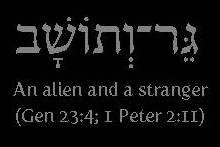Click here for the Turkey Travelogue index. Ephesus is justly famous for its extensive, well-preserved Greco-Roman and Late Antique ruins. According to the
Lonely Planet guide, it is "[t]he best-preserved classical city in the eastern Mediterranean." Excavations over the last 100+ years have exposed the ruins to public view; an on-going publication series entitled
Ephesus (1906-), and eight volumes of inscriptions, make the results of these excavations accessible to scholars who read German.
Ephesus is also a major tourist attraction, as t. and I discovered as we forced our way against the tide of people streaming down the hill towards their air-conditioned buses waiting for them in the parking lot below.
We went uphill to get our bearings. Aside from the crucial omission of modern buildings and modern paths, the map of Ephesus in the
Blue Guide is excellent. But even a good map is not much use when you are holding it upside down. By the time I concluded that the massive theatre to my left was in fact
the Theatre and not the much smaller Odeum, we decided to walk the rest of the way to the south entrance of the site, and take a more leisurely stroll downhill.
To get your bearings, consider the following photograph (taken from Ayasuluk hill in nearby Sel
çuk):

The hill in the foreground is Mount Pion; the mountain in the background is Mount Coressus. Ephesus is hidden from view in the plain behind the rightmost hills of Mount Pion, as well as in the valley between the two mountains.
Famous views of Ephesus, starting from the top of the valley and working downhill include the following:
The Odeum (built in the 2nd century A.D.), with Mt. Pion on the right:



The temple of Domitian (built during Domitian's reign, i.e., 81-96 A.D.), with Mount Coressus in the background:

The Street of the Curetes:

The Library of Celsus (built in 110 A.D.):

And last, but not least, the 24,000 seat theatre, with the Arcadian Way leading to the harbour in the foreground:

The Arcadian Way was paved in marble by the Eastern Roman Emperor Arcadius (A.D. 395-408). The theatre was first built during the Hellenistic period, but it was expanded under Roman rule in the first and second centuries A.D. It was last renovated in the 21st century, as you can see from the crane to the right of the picture.
As in Pergamum, many of the most imposing ruins in Ephesus were built during the second century. In the next entry, I'll post some images of buildings that would have been standing when Paul wandered the streets of Ephesus in the 50's A.D.
 The fortress has been closed for several years because of safety concerns, so we contented ourselves with a view from the nearby Basilica of St. John:
The fortress has been closed for several years because of safety concerns, so we contented ourselves with a view from the nearby Basilica of St. John: There's a stork's nest on the pillar (part of the nearby 14th century Isa Bey mosque) in the center of the next picture:
There's a stork's nest on the pillar (part of the nearby 14th century Isa Bey mosque) in the center of the next picture: So named because a second (?) century tomb was believed to hold the bones of John the Apostle, the Basilica of St. John was built by the Emperor Justinian in the 6th century. It has now been extensively restored. Compare the baptistery in the next picture with the less-restored, but otherwise very similar design in the 5th century Church of St. Mary in Ephesus:
So named because a second (?) century tomb was believed to hold the bones of John the Apostle, the Basilica of St. John was built by the Emperor Justinian in the 6th century. It has now been extensively restored. Compare the baptistery in the next picture with the less-restored, but otherwise very similar design in the 5th century Church of St. Mary in Ephesus: Instead of trees, sacred sites in the vicinity of Ephesus appear to be protected by storks. These two stand guard at the entrance to St. John's Basilica:
Instead of trees, sacred sites in the vicinity of Ephesus appear to be protected by storks. These two stand guard at the entrance to St. John's Basilica: We encountered this nest on our descent down the hill:
We encountered this nest on our descent down the hill: Hmm...
Hmm...













































